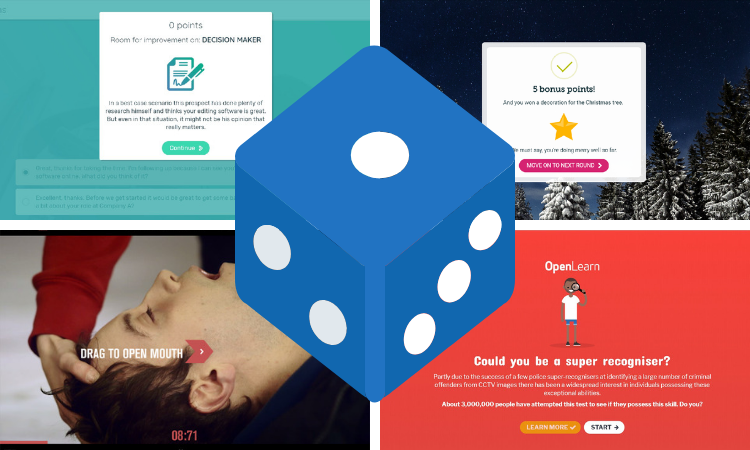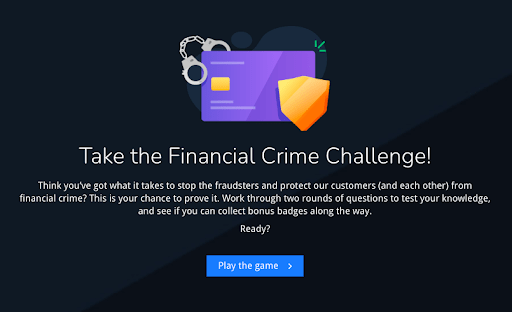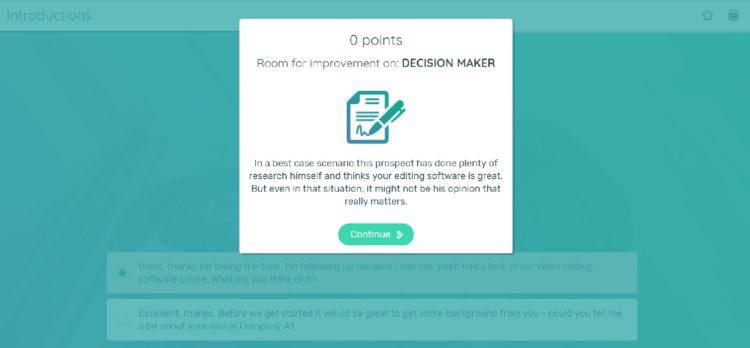5 best examples of gamification in elearning
10 minute read
Gamification is a word with a lot of baggage! Maybe you hear it, roll your eyes and think “buzzword”. Or perhaps gamification in elearning sounds a bit daunting to you? The truth is, there are loads of ways to incorporate games and gaming elements into your corporate elearning. Read on to learn more and for a few inspiring examples of gamification in elearning.

- What is gamification?
- How to use gamification in elearning?
- 5 best gamification in elearning examples
- The benefits of gamification to businesses & employees
- Challenges of gamification in elearning
- Best tips for effective gamification elearning
What is gamification?
Gamification allows you to supercharge your elearning experience. It is the strategic use of game elements to enhance the learning experience. It involves integrating features like points, badges, and leaderboards into online courses to motivate and engage learners. No more dull, passive courses. Instead with gamified elements, your elearning is transformed into an interactive and enjoyable learning experience.
How to use gamification in elearning
Now we’ve taken a look at some best practices in gamification, it’s time to see it in action. Here are five examples of gamification in elearning that show different ways to incorporate some or all of these gaming elements.
1. Stories
Create a compelling storyline to captivate your users and take them on a journey. Create a story that embeds users in the plot as they tackle each section of the content. This is a great way to create immersive content and keep learners engaged throughout. Incorporating characters or avatars to represent employees can add an extra layer of fun to this form of gamification in business.
2. Visual design
Eye-catching visuals and aesthetically pleasing designs can make your corporate elearning more appealing and draw your users in. Combine bright colours and graphics for a visually stimulating gamified learning experience.
3. Competitions
Who doesn’t love a bit of healthy competition? Gamification at work can allow users to compete against others in their team or anonymous players, or even against themselves to keep motivation levels high. Consider including leaderboards so learners can see how they’re performing against their peers. This is especially effective for sales reps and top-performing employees, who particularly want to keep achieving more.
4. Challenges
Use elearning gamification to reward your learners with smaller, more frequent tasks and then ramp up the difficulty level as the session progresses. This will not only help them get into the swing of things, but leave them primed and ready for more difficult, rewarding challenges using what they have learnt along the way.
5. Rewards
Gamify your learning to incentivize your users in the way of rewards such as badges, medals or unlocking new levels can help to boost their motivation and keep them engaged for longer periods of time.
6. Feedback
Providing instant feedback when a learner completes a task or quiz is a great way to keep them focused and engaged as it allows them to track their progress as they move through the different stages of the game.
Are you seeking additional advice on creating effective elearning with gamification? Look no further. Access the ultimate guide to transform your elearning to the next level.
5 best gamification in elearning examples
Now we’ve taken a look at some best practices for gamification in elearning, it’s time to see it in action. Here are five examples of gamification in elearning that show different ways to incorporate some or all of these gaming elements.
1. A gamified quiz with badges to motivate
When does a quiz become a game? Perhaps when visual rewards and badges are introduced alongside basic point-scoring, or maybe when a timer introduces an element of competition. This gamified elearning example does both of those things, as well as demonstrating several different question types.

This game-like quiz challenges learners to prove their financial crime knowledge. It includes question rounds that increase in difficulty, points to reward correct answers, and bonus questions with badges to collect.
Why it works:
- Gamifying quizzes with badges boosts participation by creating competition and motivating users to actively take part, resulting in higher completion rates and an immersive learning experience.
- Incorporating gamification and badges into quizzes makes learning interactive and enjoyable. Badges represent achievements, fostering a sense of progress and accomplishment, making learning enjoyable, reinforcing positive behavior, and encouraging continuous learning.
- Badges provide recognition and reinforcement for participants’ efforts. Earning badges for completing quizzes or reaching milestones validates accomplishments, boosting self-confidence, motivation, and the desire to continue participating in quizzes and learning activities.
2. Scenario + game elements = sales simulation
This gamified elearning demo shows how simple gaming mechanics can be cleverly applied to a scenario-based approach. The result: a realistic learning environment that really resonates with salespeople.

Try this sales simulation example
The elearning example provides interactive scenarios and simulations mirroring real-world sales situations. It enhances sales skills and decision-making through safe practice, fostering effective sales strategies and improving overall performance. It offers a hands-on approach for learners to develop their abilities in a realistic environment.
Why it works:
- The sense of competition and urgency created by the game mechanics is relevant to the subject, with real life scenarios reflecting a fast-paced, target-driven sales floor
- The user isn’t controlling a character; they are the character – so the stakes feel higher and the game can be more directly transferred to the workplace
- It’s a low-cost audio-driven simulation and a great demonstration of achieving gamification in employee training without huge expense
3. Product knowledge game-like quiz
Creating a sense of play in your corporate elearning is great for engagement and easy to achieve through gamification. Fun, game-like product knowledge quizzes, like the example below, are a great, interactive way to test a learner’s understanding.

Test this gamification example.
This game-like quiz is designed to enhance product knowledge by offering an interactive learning experience through gamification elements such as badges, competition, and achievements. Learners engage in the quiz to earn badges, reinforcing their learning progress and providing recognition for their achievements.
Why it works:
- With this example of elearning, question rounds are used to emphasize increased difficulty using different points assigned to different questions.
- Learners are incentivized to apply their skills correctly, making the content more likely to stick in the learner’s mind when handling a real-life situation.
- Game-like quizzes are great for the creation of content that involves high-pressure scenarios. Gamification is great for replicating this sense of pressure or less serious topics that you can have a bit of fun with.
4. Game-like quiz: General purpose
This fun, game-like quiz is made up of three rounds on your chosen subject. Each round offers the chance to win points and badges. Decide whether to formally assess learners or not.

The showcased elearning is a game-like quiz with a general purpose. It offers an engaging and interactive experience for learners through gamification elements. The quiz aims to enhance knowledge and understanding in a fun and enjoyable way and can be catered to a wide range of topics or subjects.
Why it works:
- You can appeal to the learner’s competitive spirit by rewarding correct answers, as well as providing bonus questions with badges to collect.
- The interactive nature of the elearning helps improve knowledge retention. By actively participating in the game-like quiz, learners are more likely to remember and understand the content, as they are applying it in practical scenarios.
5. Time-saving tailored retail training
This piece of elearning offers a personalized and engaging learning experience for retail professionals. It showcases how to cater to a range of learner needs by offering different paths through the content.
In this gamified elearning example, tailored retail training comes to life. Learners embark on a journey filled with interactive scenarios, practical challenges, and real-world simulations. The training focuses on enhancing customer service skills, product knowledge, and sales techniques, ensuring that each participant gains valuable skills and insights that are directly applicable to their roles in the retail industry.
Why it works:
- This type of training is great for businesses with high staff turnover, seasonal staffing, and busy learners.
- Incorporating interactive elements such as scenarios and simulations ensures that the content closely mirrors real-life situations encountered in the retail industry. This gives learners the practical skills and knowledge they can apply immediately.
The benefits of gamification for businesses & employees
Gamification in business comes with a number of benefits, both for the organization and participating users. Here, we take a look at some of the most prevalent benefits of gamifying your learning.
1. Encourages active learning
The gamification of elearning encourages learners to take an active role in their learning by providing them with ample opportunities to interact with the content. Rather than passively absorbing information, learners can test their knowledge as they go and gain instant feedback.
2. Promotes continuous learning
The competitive element of gamification can spur users on to beat their score or move to the next level, which promotes continuous learning. Users are also more likely to revisit a module if they feel they can score higher, meaning they’re more likely to retain the information through repetition.
3. Improves productivity
Incorporating gamified elements into your corporate elearning can help employees to stay engaged for longer, meaning they get through more content in less time. Instead of spending half an hour watching a training video, learners can take part in three 10-minute quizzes, for example. Research has concluded that 89% of respondents would be more productive if their work was gamified, with increased happiness levels at work.
4. Creates more enjoyable learning experiences
Not only does gamification help employees to stay engaged for longer periods of time, but it also provides a more enjoyable learning experience. This helps your digital learning become less of a chore and something users can enjoy getting stuck into, instead!
5. Allows companies to collect performance data (and track performance against learning objectives)
L&D teams can leverage gamified workplace assessments to gain useful insights into employee performance and uncover topics or concepts that employees may need further training on. This can help to inform future elearning material and identify where existing modules may need improvement.
Limitations of gamification in elearning
While gamification in elearning has many benefits, it’s not necessarily right for every purpose. In some instances, where you’re dealing with more serious or challenging topics, such as compliance, for example, it may not be appropriate to gamify your content as it may detract from the key messages or takeaways.
It’s important to treat each topic or module as unique and set your learning objectives before you decide whether gamification will be effective. Gamified content may also not be the right fit for your company depending on your company culture and/or sector, so you should also factor this in when designing your corporate elearning content.
The most effective elearning programs are tailored to their users and individual learning needs, so if gamification isn’t right for you, experiment with other formats. Check out our guide to elearning best practices for inspiration.
Best tips for elearning gamification
1. Start small but don’t cut corners
Rather than going all-in on a high-profile gamification project, target a particular business area, audience or programme and experiment with different approaches. Make sure you have some control data and gather more after implementation to assess value add. Build up to more complex or widespread implementations. Just remember, starting small doesn’t mean just adding points to a task or tacking a leaderboard onto an end-of-course quiz. The game mechanics have to serve a purpose beyond ‘making it fun’ for gamification in business to be truly beneficial.
2. Prioritise the learning, not the game
Points and competition only deliver value if they’re tied to behaviours and performance. Always get the employee training objectives straight first and design game mechanics to be in service of those. It can be worth developing a hierarchy, whereby points are easily earned (maybe for completing a profile or sharing the course) and accumulate quickly, but badges are more meaningful, offered only in return for doing something that demonstrates new knowledge, competence or skills.
3. Be clear on criteria and progression
Transparency and clarity about how the game works will keep people engaged and motivated. What tasks earn points? What do points mean? Perhaps they translate into badges or unlock new content. What’s the criteria for reaching the next level or reward? What do rewards mean in reality? (Maybe they translate into tangible or financial benefits, or serve as accreditation of a skill that opens opportunities.)
4. Ramp up the challenge gradually
Learners need frequent, easy achievements to begin with. Once they’ve got to grips with things and seen that effort reaps reward, they’re primed and ready for a bigger challenge. The aim should always be for the next level to be within sight, challenging but attainable. Even better if each new challenge requires learners to draw on what they’ve most recently learnt.
5. Don’t disregard individual competition
It isn’t always feasible or appropriate to pit learners against learners on public leaderboards – but that doesn’t mean you can’t successfully gamify your content. Social polling lets an individual see how they compare to others, but anonymously. Or take FitBit: it has the community aspect, but plenty of people use it without that. There’s something intrinsically rewarding, even slightly addictive, about setting a goal and measuring your progress towards it (then hopefully achieving it!).
6. Facilitate continuous learning
Look for ways to encourage learners to keep returning and improving their score (and therefore, their skills and competence!), such as resetting leaderboards regularly or introducing new challenges or rewards periodically. Give people a reason to keep coming back rather than considering their learning ‘done’ and you’ll be supporting a culture of continuous, informal or on-the-job development.
Summary
These four examples show that including gamification in elearning doesn’t have to be daunting. Gaming elements such as points, badges, and levels can – with a little thought – add an extra dimension to your online courses that will help engage learners and make your content stick. To discuss these gamification examples or to find out how Elucidat can help you add gamification at work, get a free personalized demo today. We can help you do it!
Want to create engaging gamified examples like these? Take your elearning to the next level with this certified course in engaging elearning design.






